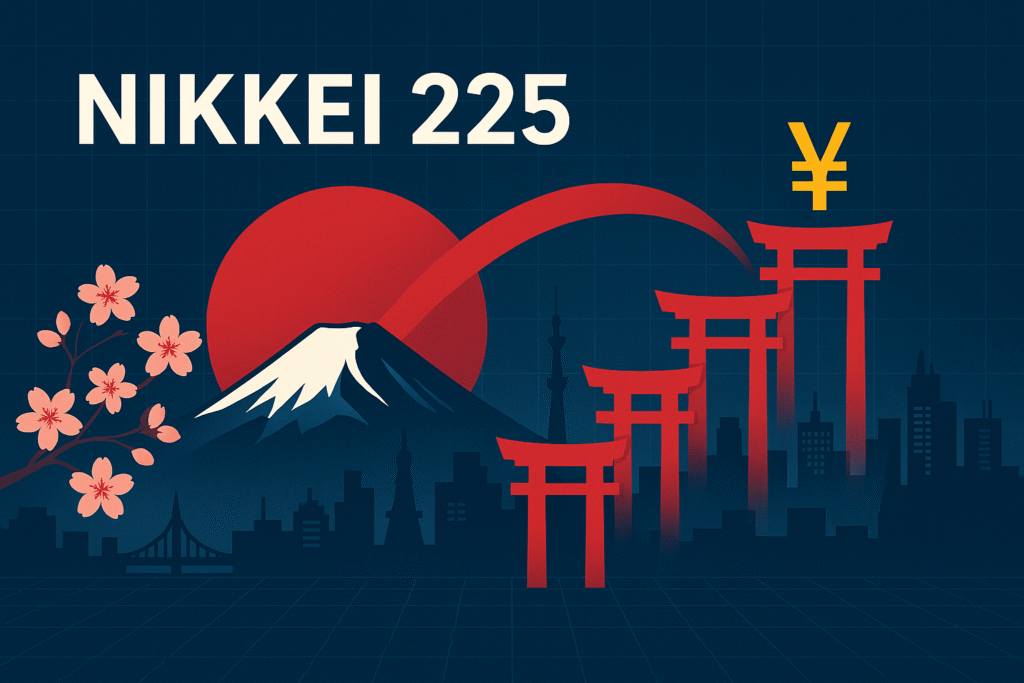Nikkei 225, the price-weighted benchmark of 225 large and liquid companies on the Tokyo Stock Exchange, tracks Japan’s corporate titans and—thereby—offers the clearest real-time gauge of the nation’s economic momentum. Consequently, investors worldwide cite the Nikkei 225 whenever they assess shifts in global risk appetite.

1. Snapshot (May 2025)
| Metric | Value | Transition Note |
|---|---|---|
| Index Level | 38 720 | To begin with, flirting with a multi-decade high. |
| Point-Base | 1949 = 100 | Meanwhile, the long history aids macro studies. |
| Currency | Japanese yen (JPY) | Accordingly, FX swings directly affect returns. |
| Dividend Yield | 1.4 % | Thus, payouts sit below TOPIX but above JGB yields. |
| Launch Year | 1950 (back-history to 1949) | Finally, eight decades of data enable deep back-tests. |
Because the Nikkei 225 is price-weighted—similar to the Dow Jones Industrial Average—high-priced shares wield greater influence regardless of market capitalisation.
2. Construction Basics
| Rule | Detail | Transition Note |
|---|---|---|
| Constituent Count | 225 Prime-Market common stocks | First and foremost, breadth spans 36 industries. |
| Weighting Method | Simple stock price ÷ divisor (≈ 26.4) | Consequently, stock splits trigger divisor tweaks. |
| Review Schedule | Annual review each October; ad-hoc changes for actions | Moreover, adjustments keep the basket relevant. |
| Liquidity Screen | Minimum trading value over six months | Hence, illiquid names are excluded. |
Through these rules, the Nikkei 225 remains liquid, export-oriented, and highly visible.
3. Sector & Stock Weights (April 2025)
| Top Sectors | Combined Weight* | High-Price Leaders | Transition Note |
|---|---|---|---|
| Technology Hardware | 31 % | Advantest, Tokyo Electron | Chiefly, chip demand drives swings. |
| Industrials | 19 % | Fanuc, Daikin | Meanwhile, robotics lever global CapEx. |
| Consumer Discretionary | 14 % | Fast Retailing, Honda | Notably, Fast Retailing alone moves ≈ 8 %. |
| Financials | 10 % | Nomura, Dai-ichi Life | Thus, BOJ policy impacts earnings. |
| Health Care | 8 % | Eisai, Terumo | Additionally, ageing demographics boost demand. |
*Price-weight contribution. Because Fast Retailing’s share price is lofty, it punches far above its market-cap weight—therefore, the Nikkei 225 responds sharply to its moves.
4. Recent Performance (Total Return, JPY)
| Year | % Return | Key Drivers | Transition Note |
|---|---|---|---|
| 2022 | –7.0 % | Yen slide offset by global rate fears | Initially, tightening headwinds prevailed. |
| 2023 | +28.2 % | Governance reforms, AI-chip demand | Subsequently, optimism surged. |
| 2024 | +13.5 % | BOJ exits YCC, earnings momentum | Moreover, policy shift propelled multiples. |
| YTD 2025 | +5.7 % | Weak yen, tech upgrades | So far, exporters power gains. |
Volatility averages 17 %, placing the Nikkei 225 between calmer developed indices and livelier EM benchmarks.
5. Why Investors Follow the Nikkei 225
- International Visibility. Quoted everywhere as Japan’s “Dow”; therefore, media headlines move flows.
- Derivatives Liquidity. CME and Osaka futures trade around the clock; consequently, hedging is seamless.
- Sector Representation. Captures export-heavy tech, industrial, and consumer titans; thus, it mirrors global demand.
- ETF Underpinning. Vehicles like EWJ (USD) and TSE-listed 1321 replicate the Nikkei 225, thereby granting low-cost access.
6. Strengths & Caveats
| Strengths | Caveats |
|---|---|
| Long history, continuous data since 1949. | Price weighting overemphasises expensive shares; Fast Retailing can swing the index. |
| High-turnover liquidity. | 225 names omit many domestic mid-caps found in TOPIX. |
| Broad industry mix. | Financials under-weighted versus market-cap indices. |
| Robust derivatives market. | Dividend yield lower than global peers. |
7. Current Themes
- Corporate Reform. TSE’s ROE push fuels buybacks—thereby boosting the Nikkei 225 earnings outlook.
- Weak Yen Tailwind. Exporters gain pricing power; however, foreign investors may hedge FX risk.
- Semiconductor Investment. Subsidies elevate equipment makers—thus lifting technology weighting.
- Inflation’s Return. Rising wages could finally spark domestic-demand stocks, furthermore balancing exporter dominance.
Key Takeaways
The Nikkei 225 stands as Japan’s blue-chip bellwether—price-weighted, history-rich, and dominated by high-priced tech and industrial names. At roughly 38 700, the index benefits from yen weakness and governance change. Ultimately, investors tap futures, ETFs, and ADRs for exposure, yet they must recognise the price-weight quirks that set the Nikkei 225 apart from market-cap benchmarks such as TOPIX.